Acoelomate - Study guides, Class notes & Summaries
Looking for the best study guides, study notes and summaries about Acoelomate? On this page you'll find 54 study documents about Acoelomate.
Page 2 out of 54 results
Sort by
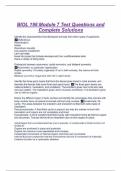
-
BIOL 198 Module 7 Test Questions and Complete Solutions
- Exam (elaborations) • 16 pages • 2024
-
Available in package deal
-
- $10.49
- + learn more
Identify the characteristics that distinguish animals from other types of organisms. Multicellular Heterotrophic Motile Reproduce sexually Use aerobic metabolism Lack cell walls Have life cycles that include development from undifferentiated cells Have a variety of body plans Distinguish between asymmetry, radial symmetry, and bilateral symmetry. Asymmetry: no particular organization Radial symmetry: Circularly organized. If cut in half vertically, the halves will look similar. Bilateral symmet...
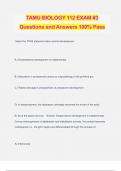
-
TAMU BIOLOGY 112 EXAM #3 Questions and Answers 100% Pass
- Exam (elaborations) • 33 pages • 2024
-
- $13.49
- + learn more
TAMU BIOLOGY 112 EXAM #3 Questions and Answers 100% Pass Select the TRUE statement about animal development: A.) Deuterostome development is indeterminate. B.) Mesoderm in protostomes arises as outpocketings of the primitive gut. C.) Radial cleavage is characteristic of protostome development. D) In deuterostomes, the blastopore ultimately becomes the mouth of the adult. E) All of the above are true. - Answer- Deuterostome development is indeterminate. During embryogenesis of diploblasti...
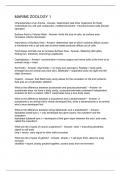
-
Marine Zoology #1
- Exam (elaborations) • 3 pages • 2024
-
- $9.99
- + learn more
Characteristics of an Animal - Answer- heterotroph (eat other organisms for food), multicellular (no cell wall, eukaryotic), motility/movement, *neurons/muscle cells (except sponges) Surface Area to Volume Ratio - Answer- limits the size of cells, as surface area increases volume decreases Importance of Surface Area - Answer- determines rate at which nutrients diffuse across a membrane into a cell and rate at which waste products diffuse out of cells Techniques Animals use to Increase S...
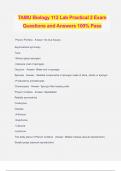
-
TAMU Biology 112 Lab Practical 2 Exam Questions and Answers 100% Pass
- Exam (elaborations) • 23 pages • 2024
-
- $12.49
- + learn more
TAMU Biology 112 Lab Practical 2 Exam Questions and Answers 100% Pass Phylum Porifera - Answer- No true tissues Asymmetrical symmetry Taxa: -Silicea (glass sponges) -Calcarea (rest of sponges) Osculum - Answer- Water exit in sponges Spicules - Answer- -Skeletal components of sponges made of silica, calcite or spongin -Produced by amoebocytes Choanocytes - Answer- Spong's filter-feeding cells Phylum Cnidaria - Answer- Diploblastic Radially symmetrical Cnidocytes Classes: -Anthozoa...
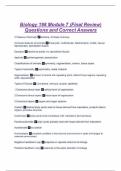
-
Biology 198 Module 7 (Final Review) Questions and Correct Answers
- Exam (elaborations) • 6 pages • 2024
-
Available in package deal
-
- $8.99
- + learn more
3 Classes of Animals Bacteria, Archaea, Eukarya Common features of animals Eukaryotic, multicellular, heterotrophic, motile, sexual reproduction, specialized tissues Sponges sessile as adults, no specialized tissues daphnia parthenogenetic reproduction Classifications of animals symmetry, segmentation, coelom, tissue layers Types of symmetry asymmetry, radial, bilateral Segmentation division of animal into repeating parts, distinct body regions, repeating units, specialization Types of Ti...
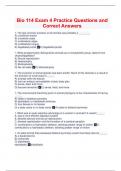
-
Bio 114 Exam 4 Practice Questions and Correct Answers
- Exam (elaborations) • 16 pages • 2024
-
Available in package deal
-
- $10.49
- + learn more
1. The last common ancestor of all animals was probably a ________. A) unicellular chytrid B) unicellular yeast C) multicellular algae D) multicellular fungus E) flagellated protist E) flagellated protist 1. What synapomorphy distinguishes animals as a monophyletic group, distinct from choanoflagellates? A) Sexual reproduction B) Heterotrophy C) Multicellularity D) No cell walls C) Multicellularity 1. The evolution of animal species has been prolific. Much of this diversity is a result of the ...
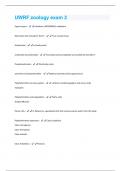
-
UWRF zoology exam 2 Questions Perfectly Answered!!
- Exam (elaborations) • 4 pages • 2024
- Available in package deal
-
- $7.99
- + learn more
3 germ layers - ectoderm, MESODERM, endoderm What does the mesoderm form? - True muscle tissue Acoelomate - no body cavity coelomate (eucoelomate) - True body cavity completely surrounded by mesoderm Pseudocoelomate - false body cavity symmetry of platyhelminthes - bilateral symmetry (first appearance) Platyhelminthes nervous system - -Anterior cerebral ganglion and nerve cords -Eyespots Platyhelminthes osmoregulation - Flame cells Simple diffusion Flame cells - In flatworms, specializ...
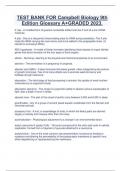
-
TEST BANK FOR Campbell Biology 9th Edition Glossary A+GRADED 2023.
- Exam (elaborations) • 138 pages • 2023
-
- $16.49
- + learn more
5′ cap - A modified form of guanine nucleotide added onto the 5′ end of a pre-mRNA molecule. A site - One of a ribosome's three binding sites for tRNA during translation. The A site holds the tRNA carrying the next amino acid to be added to the polypeptide chain. (A stands for aminoacyl tRNA.) ABC hypothesis - A model of flower formation identifying three classes of organ identity genes that direct formation of the four types of floral organs. abiotic - Nonliving; referring to th...
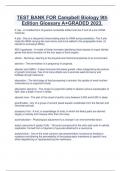
-
TEST BANK FOR Campbell Biology 9th Edition Glossary A
- Exam (elaborations) • 138 pages • 2023
-
- $23.99
- + learn more
TEST BANK FOR Campbell Biology 9th Edition Glossary A 5′ cap - A modified form of guanine nucleotide added onto the 5′ end of a pre-mRNA molecule. A site - One of a ribosome's three binding sites for tRNA during translation. The A site holds the tRNA carrying the next amino acid to be added to the polypeptide chain. (A stands for aminoacyl tRNA.) ABC hypothesis - A model of flower formation identifying three classes of organ identity genes that direct formation of the four types of f...
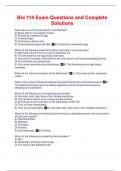
-
Bio 114 Exam Questions and Complete Solutions
- Exam (elaborations) • 8 pages • 2024
-
Available in package deal
-
- $8.99
- + learn more
What was one of the innovations of the Reptilia? A) Being able to live outside of water. B) Producing a waterproof egg. C) Powered flight. D) Producing a spinal cord. E) Producing pharyngeal gill slits. B) Producing a waterproof egg. Which of the following statements about mammals is most accurate? A) Mammals were the first to evolve a post-anal tail. B) The Monotremes are egg-laying mammals. C) Among the Chordata, mammals are the only ones to not have pharyngeal gill slits. D) All mammals are ...

Did you know that on average a seller on Stuvia earns $82 per month selling study resources? Hmm, hint, hint. Discover all about earning on Stuvia


